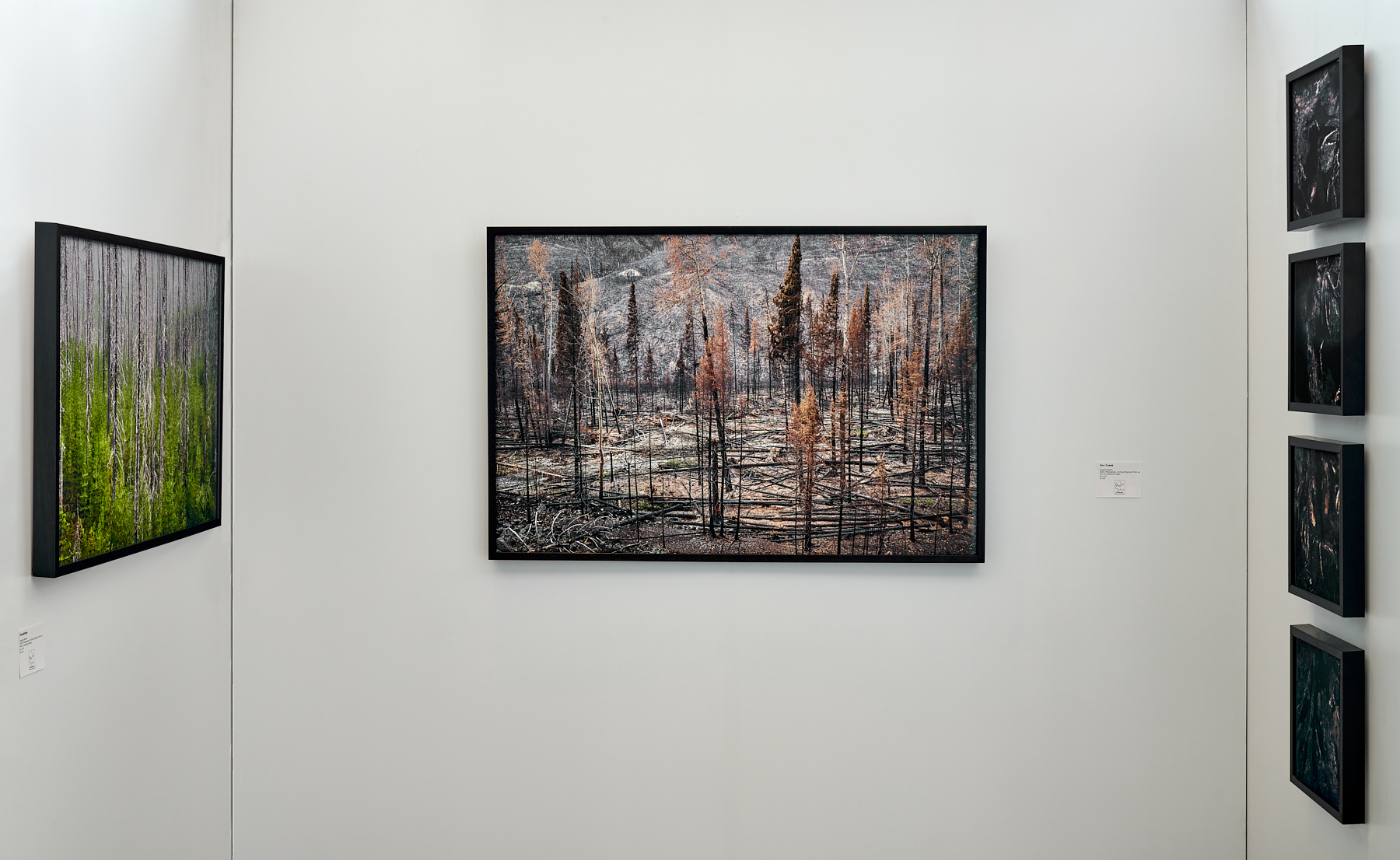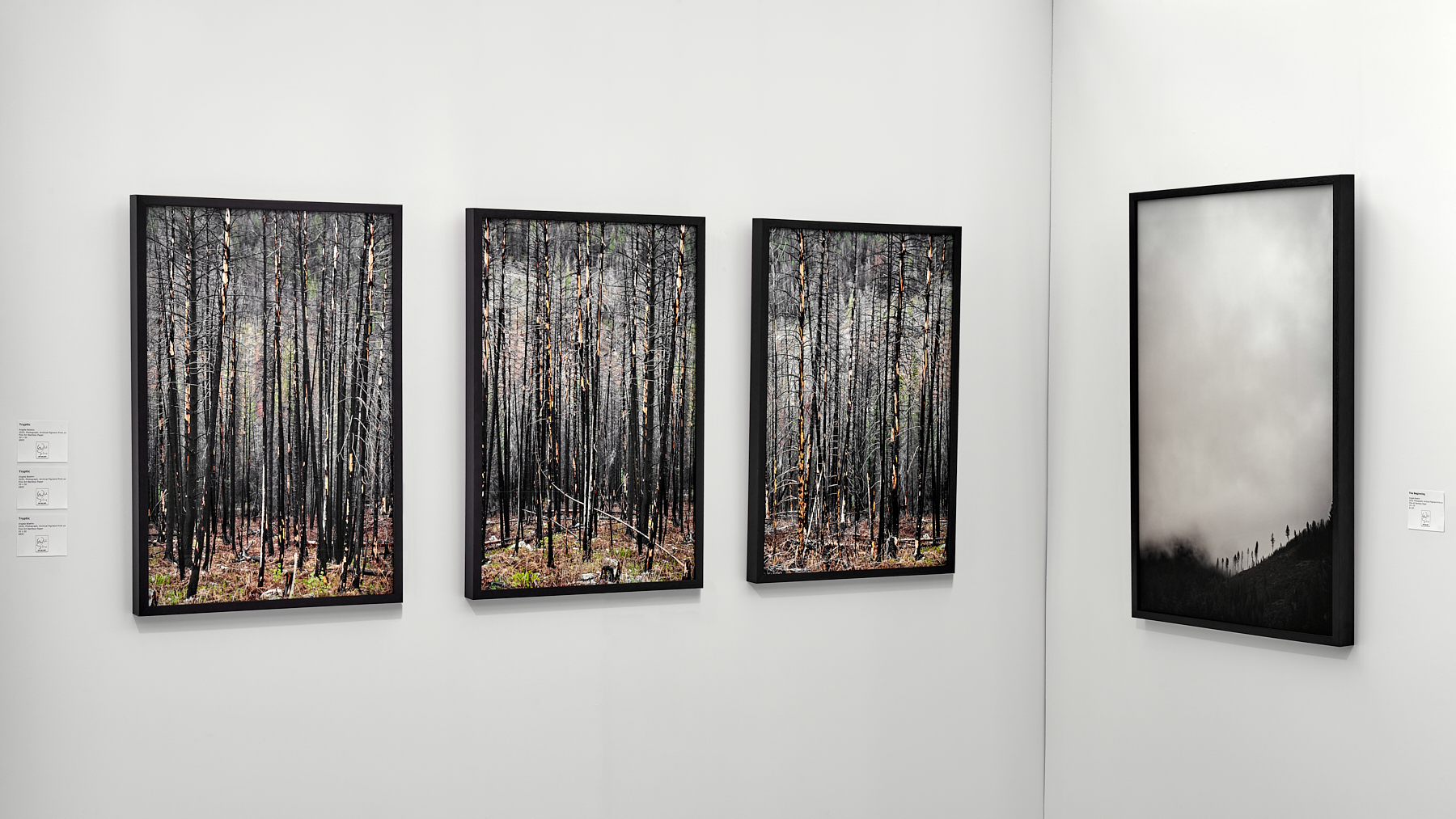“The Giving Trees” by Angela Boehm is a photographic exhibition portraying forests post-burn covering a 25-year timeline of fires. The images share both the ephemeral repose of a burned forest and the strength of its regeneration. Images are from forest fires started by lightening during the years 2003 to 2020 in various locations in Alberta and BC.
Recent fires in Alberta near residential areas have been disastrous for communities. It has put us all on edge with concern for fires, including in our forests. The narrative around fires has shifted to one that all fires are disasters. For decades policies have prevented forest fires, producing highly flammable homogenous forests, where the dominant species chokes out much of the variety of life. In prior eras, fire was one of the prominent renewal disturbances of forests.
The narrative surrounding forest fires is deserving of adjustment – one that is balanced with the “good fires,” an integral part of forest life. As a documentary photographer, conveying this positive message is Angela Boehm’s motivation to carefully photograph forests following fire in various stages of regeneration for others to witness. Working with researchers at both the University of Alberta and the University of Calgary, as well as informing herself through interviews with fire management personnel in our parks, and interviewing those with knowledge of indigenous fires practices, Boehm has come to see that fire is yet another process in nature, with its own unique beauty. That the lightning strikes in our forests are part of their cycle and are the impetus of much new life.
To find these areas where fire has started renewal, Angela Boehm packs up her off road vehicle and heads deep into the uninhabited areas of Alberta. Using a combination of fire access roads and logging roads, she ventures as deep and remote as she can before heading out on foot. Once there, with a pack of cameras on her back, Boehm wanders into these burned forests and lets them show her and her camera how life is returning. She is frequently awe struck by yet another beauty in nature, one much less appreciated. Her eye, and by extension her camera, are drawn to the charred remains of a forest. The silence that accompanies it is unique, no leaves in the breeze, no birds in a nest. Nature intended this temporary silence, and, as an artist, Boehm is grateful for having experienced it.
It is Angela Boehm’s intent through this project that many come to remember how fire is a part of nature, how it is not the end of life in the woods but the beginning of a renewing process that will spark rapid growth of many species. It is her hope that when people hear of fire in the forest they can pause and consider the life that will spring forward.
Angela Boehm Artist Statement:
I realized I was driving through a timeline of forest fires.
During a drive through the mountains in British Columbia, a winding scenic route we typically follow on the way to our favourite lake, I realized I was driving through a timeline of forest fires. There had been many fires in this area over the last few decades since we started these summer excursions, and today what I saw was a forest in many different stages of regeneration: tufts of foliage, vibrant green, seedlings racing upwards, thick populations of young trees surrounding their charred elders. This transformation is fast, vibrant, thick and surprising. One could even describe it as forceful. I realized that what I was seeing was not pure devastation and loss, but a message of hope. I was witnessing the resilience of nature, the tenacity of a forest to live. So, I began to photograph these burned lands, to celebrate the forest’s renewal.
Appreciating fire is part of nature’s process: “good” fires, I have since learned, are an integral part of forest life. As a documentary photographer, conveying this positive message is my motivation for this project. I carefully photograph forests in various stages of regeneration, following fire – from recent burns to those that have occurred years ago. The photographs in this series are all from uninhabited areas of the forest, and all from lightning strikes.
I ventured out into the forests during the pandemic, staying close to home. But the forest drew me in for other reasons. Three personal losses of people close to me preceded this journey. I see these fires and the recovery of these forests through a world struggling to make sense of the monumental pandemic losses we have faced together – the loss of life, of ways of life, and the ways of approaching life – as well as through personal tragedy. These are places of silence and regeneration, once ravaged, again thriving.
I am grateful to those who have contributed their considerable time and wisdom to this project. Academics at the University of Alberta and the University of Calgary provided me with science-based insight into the long-term impact of fire. Fire management personnel in our Canadian Parks system informed my understanding of policy and practical aspects related to fire management and behaviour. In recent times, we have learned that the oral histories of Canada’s indigenous peoples contain vital insights into fire as part of forest, nature and wildlife management. Interviewing those with knowledge of indigenous fire practices has informed my perspective on “breathing good fire into the landscape.” I’ve come to understand that fire is yet another habitual process in nature, with its own unique beauty and logic. It is part of the life cycle of a forest and the start of much new life.
It’s my hope that through this exhibit, viewers will come to appreciate how fire is a part of nature, how fire is not the end of life in the woods, but the beginning of a renewing process that will inevitably spark rapid growth of many species, even some that need fire to be born. It is my hope that when people hear of fire occurring in a nearby forest they will pause and consider the life that will spring forward when the fire clears.







